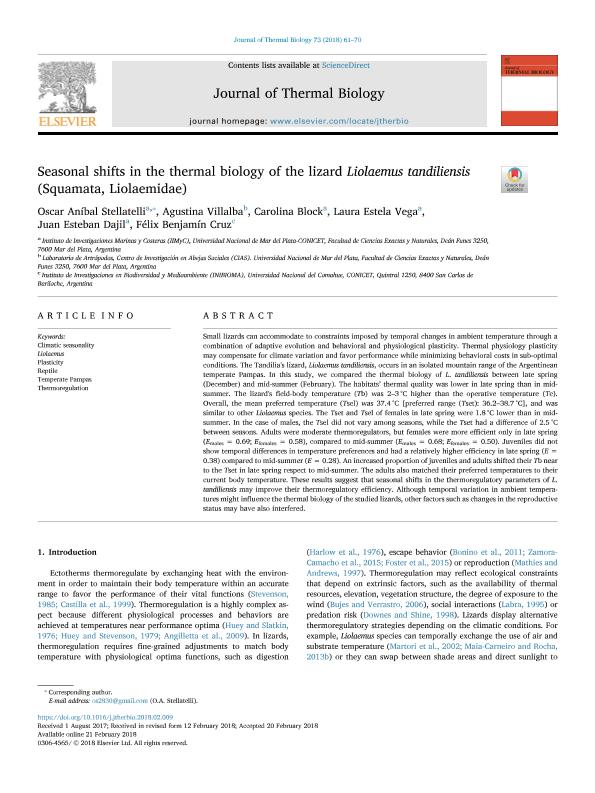Mostrar el registro sencillo del ítem
dc.contributor.author
Stellatelli, Oscar Aníbal

dc.contributor.author
Villalba, Agustina

dc.contributor.author
Block, Carolina

dc.contributor.author
Vega, Laura Estela

dc.contributor.author
Dajil, Juan Esteban
dc.contributor.author
Cruz, Felix Benjamin

dc.date.available
2019-10-18T16:01:46Z
dc.date.issued
2018-04
dc.identifier.citation
Stellatelli, Oscar Aníbal; Villalba, Agustina; Block, Carolina; Vega, Laura Estela; Dajil, Juan Esteban; et al.; Seasonal shifts in the thermal biology of the lizard Liolaemus tandiliensis (Squamata, Liolaemidae); Pergamon-Elsevier Science Ltd; Journal of Thermal Biology; 73; 4-2018; 61-70
dc.identifier.issn
0306-4565
dc.identifier.uri
http://hdl.handle.net/11336/86371
dc.description.abstract
Small lizards can accommodate to constraints imposed by temporal changes in ambient temperature through a combination of adaptive evolution and behavioral and physiological plasticity. Thermal physiology plasticity may compensate for climate variation and favor performance while minimizing behavioral costs in sub-optimal conditions. The Tandilia´s lizard, Liolaemus tandiliensis, occurs in an isolated mountain range of the Argentinean temperate Pampas. In this study, we compared the thermal biology of L. tandiliensis between late spring (December) and mid-summer (February). The habitats? thermal quality was lower in late spring than in midsummer. The lizard´s field-body temperature (Tb) was 2?3 °C higher than the operative temperature (Te). Overall, the mean preferred temperature (Tsel) was 37.4 °C [preferred range (Tset): 36.2?38.7 °C], and wassimilar to other Liolaemus species. The Tset and Tsel of females in late spring were 1.8 °C lower than in midsummer. In the case of males, the Tsel did not vary among seasons, while the Tset had a difference of 2.5 °C between seasons. Adults were moderate thermoregulators, but females were more efficient only in late spring (Emales = 0.69; Efemales = 0.58), compared to mid-summer (Emales = 0.68; Efemales = 0.50). Juveniles did not show temporal differences in temperature preferences and had a relatively higher efficiency in late spring (E = 0.38) compared to mid-summer (E=0.28). An increased proportion of juveniles and adults shifted their Tb near to the Tset in late spring respect to mid-summer. The adults also matched their preferred temperatures to their current body temperature. These results suggest that seasonal shifts in the thermoregulatory parameters of L. tandiliensis may improve their thermoregulatory efficiency. Although temporal variation in ambient temperatures might influence the thermal biology of the studied lizards, other factors such as changes in the reproductive status may have also interfered.
dc.format
application/pdf
dc.language.iso
eng
dc.publisher
Pergamon-Elsevier Science Ltd

dc.rights
info:eu-repo/semantics/openAccess
dc.rights.uri
https://creativecommons.org/licenses/by-nc-sa/2.5/ar/
dc.subject
CLIMATE SEASONALITY
dc.subject
LIOLAEMUS
dc.subject
PLASTICITY
dc.subject
REPTILE
dc.subject
TEMPERATE PAMPAS
dc.subject
THERMOREGULATION
dc.subject.classification
Biología

dc.subject.classification
Ciencias Biológicas

dc.subject.classification
CIENCIAS NATURALES Y EXACTAS

dc.title
Seasonal shifts in the thermal biology of the lizard Liolaemus tandiliensis (Squamata, Liolaemidae)
dc.type
info:eu-repo/semantics/article
dc.type
info:ar-repo/semantics/artículo
dc.type
info:eu-repo/semantics/publishedVersion
dc.date.updated
2019-10-10T13:46:22Z
dc.identifier.eissn
1879-0992
dc.journal.volume
73
dc.journal.pagination
61-70
dc.journal.pais
Estados Unidos

dc.journal.ciudad
Amsterdam
dc.description.fil
Fil: Stellatelli, Oscar Aníbal. Consejo Nacional de Investigaciones Científicas y Técnicas. Centro Científico Tecnológico Conicet - Mar del Plata. Instituto de Investigaciones Marinas y Costeras. Universidad Nacional de Mar del Plata. Facultad de Ciencias Exactas y Naturales. Instituto de Investigaciones Marinas y Costeras; Argentina
dc.description.fil
Fil: Villalba, Agustina. Universidad Nacional de Mar del Plata. Facultad de Ciencias Exactas y Naturales. Departamento de Biología; Argentina
dc.description.fil
Fil: Block, Carolina. Consejo Nacional de Investigaciones Científicas y Técnicas. Centro Científico Tecnológico Conicet - Mar del Plata. Instituto de Investigaciones Marinas y Costeras. Universidad Nacional de Mar del Plata. Facultad de Ciencias Exactas y Naturales. Instituto de Investigaciones Marinas y Costeras; Argentina
dc.description.fil
Fil: Vega, Laura Estela. Consejo Nacional de Investigaciones Científicas y Técnicas. Centro Científico Tecnológico Conicet - Mar del Plata. Instituto de Investigaciones Marinas y Costeras. Universidad Nacional de Mar del Plata. Facultad de Ciencias Exactas y Naturales. Instituto de Investigaciones Marinas y Costeras; Argentina
dc.description.fil
Fil: Dajil, Juan Esteban. Consejo Nacional de Investigaciones Científicas y Técnicas. Centro Científico Tecnológico Conicet - Mar del Plata. Instituto de Investigaciones Marinas y Costeras. Universidad Nacional de Mar del Plata. Facultad de Ciencias Exactas y Naturales. Instituto de Investigaciones Marinas y Costeras; Argentina
dc.description.fil
Fil: Cruz, Felix Benjamin. Consejo Nacional de Investigaciones Científicas y Técnicas. Centro Científico Tecnológico Conicet - Patagonia Norte. Instituto de Investigaciones en Biodiversidad y Medioambiente. Universidad Nacional del Comahue. Centro Regional Universidad Bariloche. Instituto de Investigaciones en Biodiversidad y Medioambiente; Argentina
dc.journal.title
Journal of Thermal Biology

dc.relation.alternativeid
info:eu-repo/semantics/altIdentifier/url/http://linkinghub.elsevier.com/retrieve/pii/S0306456517303108
dc.relation.alternativeid
info:eu-repo/semantics/altIdentifier/doi/http://dx.doi.org/10.1016/j.jtherbio.2018.02.009
Archivos asociados
